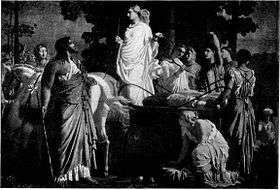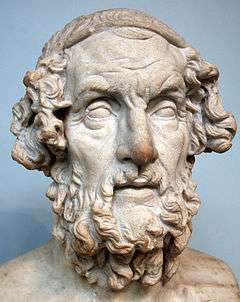Odyssey
The Odyssey (/ˈɒdəsi/;[1] Greek: Ὀδύσσεια, Odýsseia; Attic Greek: [o.dýs.sej.ja]) is one of two major ancient Greek epic poems attributed to Homer. It is, in part, a sequel to the Iliad, the other Homeric epic. The Odyssey is a fundamental work in the modern Western canon, being the oldest extant piece of Western literature, second to the Iliad. Scholars believe the Odyssey was composed near the end of the 8th century BC, somewhere in Ionia, the Greek coastal region of Anatolia.[2]

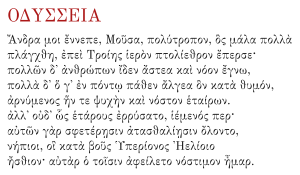
| Greek mythology |
|---|
 |
| Deities |
| Heroes and heroism |
| Related |
|
|
|
The poem mainly focuses on the Greek hero Odysseus (known as Ulysses in Roman myth), king of Ithaca, and his journey home after the fall of Troy. It takes Odysseus ten years to reach Ithaca after the ten-year Trojan War.[lower-roman 1] In his absence, Odysseus is assumed to have died, due to which his wife Penelope and son Telemachus must deal with a group of unruly suitors, the Mnesteres (Greek: Μνηστῆρες) or Proci, who compete for Penelope's hand in marriage.
The work continues to be read in the Homeric Greek and translated into modern languages around the world. Many scholars believe the original poem was composed in an oral tradition by an aoidos (epic poet/singer), perhaps a rhapsode (professional performer), and was more likely intended to be heard than read.[2] The details of the ancient oral performance and the story's conversion to a written work inspire continual debate among scholars.[3]
The Odyssey was written in a poetic dialect of Greek—a literary amalgam of Aeolic, Ionic, and other Ancient Greek dialects—comprising 12,110 lines of dactylic hexameter.[4][5] Among the most noteworthy elements of the text are its non-linear plot, and the influence on events of choices made by women and slaves, besides the actions of fighting men. In the English language, as well as many others, the word odyssey has come to refer to an epic voyage.
The Odyssey has a lost sequel, the Telegony, which was not attributed to Homer, but rather, in antiquity, to Cinaethon of Sparta. In one source, the Telegony is said to have been stolen from Musaeus of Athens by either Eugamon or Eugammon of Cyrene (see Cyclic Poets).
Synopsis
Exposition
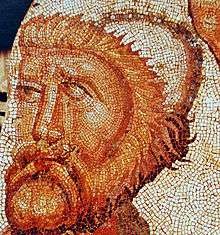
The Odyssey begins after the end of the ten-year Trojan War (the subject of the Iliad), from which Odysseus, king of Ithaca, has still not returned due to angering Poseidon, the god of the sea. Odysseus' son, Telemachus, is about 20 years old and is sharing his absent father's house on the island of Ithaca with his mother Penelope and "the Suitors," a crowd of 108 boisterous young men who each aim to persuade Penelope for her hand in marriage, all the while reveling in the king's palace and eating up his wealth.
Odysseus' protectress, the goddess Athena, asks Zeus, king of the gods, to finally allow Odysseus to return home when Poseidon, who will be gone to accept a sacrifice in Ethiopia, is absent from Mount Olympus. Then, disguised as a Taphian chieftain named Mentes, Athena visits Telemachus to urge him to search for news of his father. He offers her hospitality; they observe the suitors dining rowdily while Phemius, the bard, performs a narrative poem for them. Penelope objects to Phemius' theme, the "Return from Troy",[lower-roman 2] because it reminds her of her missing husband, but Telemachus rebuts her objections, asserting his role as head of the household.
That night, Athena, disguised as Telemachus, finds a ship and crew for the true prince. The next morning, Telemachus calls an assembly of citizens of Ithaca to discuss what should be done with the insolent suitors, who then scoff at Telemachus—especially their leaders, Antinous, Eurymachus, and Leiocritus. Accompanied by Athena (now disguised as Mentor), the son of Odysseus departs for the Greek mainland, to the household of Nestor, most venerable of the Greek warriors at Troy, who resided in Pylos after the war.
From there, Telemachus rides overland to Sparta, accompanied by Nestor's son, Peisistratus. There he finds Menelaus and Helen, who are now reconciled. While Helen laments the fit of lust brought on by Aphrodite that sent her to Troy with Paris, Menelaus recounts how she betrayed the Greeks by attempting to imitate the voices of the soldiers' wives while they were inside the Trojan Horse. Telemachus also hears from Helen, who is the first to recognize him, that she pities him because Odysseus was not there for him in his childhood because he went to Troy to fight for her and also about his exploit of stealing the Palladium (or the Luck of Troy), where she was the only one to recognize him. Menelaus, meanwhile, also praises Odysseus as an irreproachable comrade and friend, lamenting the fact that they were not only unable to return together from Troy but that Odysseus is yet to return.
Both Helen and Menelaus also say that they returned to Sparta after a long voyage by way of Egypt. There, on the island of Pharos, Menelaus encounters the old sea-god Proteus, who told him that Odysseus was a captive of the nymph Calypso. Incidentally, Telemachus learns the fate of Menelaus' brother, Agamemnon, king of Mycenae and leader of the Greeks at Troy: he was murdered on his return home by his wife Clytemnestra and her lover Aegisthus. The story briefly shifts to the suitors, who have only just now realized that Telemachus is gone. Angry, they formulate a plan to ambush his ship and kill him as he sails back home. Penelope overhears their plot and worries for her son's safety.
Escape to the Phaeacians
The second part of the epic recounts the story of Odysseus. In the course of his seven years in captivity of Calypso on the island of Ogygia, she has fallen deeply in love with him, even though he has consistently spurned her offer of immortality as her husband and still mourns for home. She is ordered to release him by the messenger god Hermes, who has been sent by Zeus in response to Athena's plea. Odysseus builds a raft and is given clothing, food, and drink by Calypso. When Poseidon learns that Odysseus has escaped, he wrecks the raft but, helped by a veil given by the sea nymph Ino, Odysseus swims ashore on Scherie, the island of the Phaeacians. Naked and exhausted, he hides in a pile of leaves and falls asleep.
The next morning, awakened by the laughter of girls, he sees the young Nausicaä, who has gone to the seashore with her maids to wash clothes after Athena told her in a dream to do so. He appeals to her for help. She encourages him to seek the hospitality of her parents, Arete and Alcinous (or Alkinous). Odysseus is welcomed and is not at first asked for his name, but Alcinous promises to provide him a ship to return him to his home country.
He remains for several days, and is goaded into taking part in a discus throw by the taunts of Euryalus, impressing the Phaeacians with his incredible athletic ability. Afterwards, he hears the blind singer Demodocus perform two narrative poems. The first is an otherwise obscure incident of the Trojan War, the "Quarrel of Odysseus and Achilles;" the second is the amusing tale of a love affair between two Olympian gods, Ares and Aphrodite. Finally, Odysseus asks Demodocus to return to the Trojan War theme and tell of the Trojan Horse, a stratagem in which Odysseus had played a leading role. Unable to hide his emotion as he relives this episode, Odysseus at last reveals his identity. He then begins to tell the story of his return from Troy.
Odysseus' account of his adventures
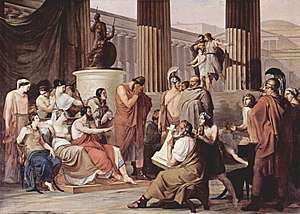
Odysseus goes back in time and recounts his story to the Phaeacians. After a failed piratical raid on Ismaros in the land of the Cicones, Odysseus and his twelve ships were driven off course by storms. Odysseus visited the lethargic Lotus-Eaters who gave his men their fruit that caused them to forget their homecoming, so Odysseus had to drag them back to the ship by force.
Afterwards, Odysseus and his men landed on a lush, uninhabited island near the land of the Cyclopes. The men then landed on shore and entered the cave of Polyphemus, where they found all the cheeses and meat they desired. Upon returning home, Polyphemus sealed the entrance with a massive boulder and proceeded to eat Odysseus' men. Odysseus devised an escape plan in which he, identifying himself as "Nobody," plied Polyphemus with wine and blinded him with a wooden stake. When Polyphemus cried out, his neighbors left after Polyphemus claimed that "Nobody" had attacked him. Odysseus and his men finally escaped the cave by hiding on the underbellies of the sheep as they were let out of the cave.
While they were escaping, however, Odysseus foolishly taunted Polyphemus and revealed his true identity. Recalling that had been prophesied by appeals to his father Poseidon, Polyphemus prayed to him, asking him to curse Odysseus to wander the sea for ten years, during which he would lose all his crew and return home through the aid of others. After the escape, Odysseus and his crew stayed with Aeolus, a king endowed by the gods with the winds. He gave Odysseus a leather bag containing all the winds, except the west wind, a gift that should have ensured a safe return home. Just as Ithaca came into sight, the greedy sailors naively opened the bag while Odysseus slept, thinking it contained gold. All of the winds flew out and the resulting storm drove the ships back the way they had come. Aeolus, recognizing that Odysseus has drawn the ire of the gods, refused to further assist him.
The men then re-embarked and encountered the cannibalistic Laestrygonians. All of Odysseus' ships except his own entered the harbor of the Laestrygonians' Island and were immediately destroyed. He sailed on and reached the island of Aeaea where he visited the witch-goddess Circe, daughter of the sun-god Helios. She turned half of his men into swine after feeding them drugged cheese and wine. Hermes warned Odysseus about Circe and gave Odysseus an herb called moly which gave him resistance to Circe's magic. Odysseus forced the now-powerless Circe to change his men back to their human form, and was subsequently seduced by her.
They remained with her on the island for one year, while they feasted and drank. Finally, guided by Circe's instructions, Odysseus and his crew crossed the ocean and reached a harbor at the western edge of the world, where Odysseus sacrificed to the dead. He first encountered the spirit of Elpenor, a crewman who had gotten drunk and fallen from a roof to his death on Aeaea. Elpenor's ghost told Odysseus to bury his body, which Odysseus promised to do. Odysseus then summoned the spirit of the prophet Tiresias for advice on how to appease Poseidon upon his return home, and was told that he may return home if he is able to stay himself and his crew from eating the sacred livestock of Helios on the island of Thrinacia and that failure to do so would result in the loss of his ship and his entire crew. Next Odysseus met the spirit of his own mother, Anticlea, who had died of grief during his long absence. From her, he got his first news of his own household, threatened by the greed of the Suitors. Finally, he met the spirits of famous men and women. Notably, he encountered the spirit of Agamemnon, of whose murder he now learned, and Achilles, who lamented the woes of the land of the dead but was comforted in hearing of the success of his son Neoptolemus (for Odysseus' encounter with the dead, see also Nekuia).
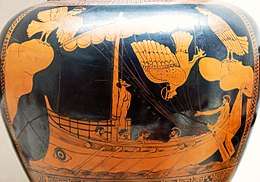
Returning to Aeaea, they buried Elpenor and were advised by Circe on the remaining stages of the journey. They skirted the land of the Sirens, who sang an enchanting song that normally caused passing sailors to steer toward the rocks, only to hit them and sink. All of the sailors had their ears plugged up with beeswax, except for Odysseus, who was tied to the mast as he wanted to hear the song. He told his sailors not to untie him as it would only make him want to drown himself. They then passed between the six-headed monster Scylla and the whirlpool Charybdis, narrowly avoiding death, even though Scylla snatched up six men.
Next, they landed on the island of Thrinacia, with the crew overriding Odysseus's wishes to remain away from the island. Zeus caused a storm which prevented them leaving, causing them to deplete the food given to them by Circe. While Odysseus was away praying, his men ignored the warnings of Tiresias and Circe and hunted the sacred cattle of Helios. The Sun God insisted that Zeus punish the men for this sacrilege. They suffered a shipwreck as they were driven towards Charybdis, and all but Odysseus were drowned. Odysseus clung to a fig tree above Charybdis. Washed ashore on the island of Ogygia, he was compelled to remain there as Calypso's lover, bored, homesick and trapped on her small island, until she was ordered by Zeus, via Hermes, to release Odysseus. Odysseus did not realise how long it would take to get home to his family.
Return to Ithaca
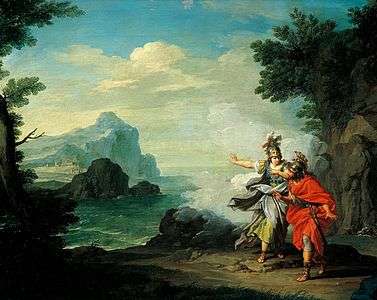
Having listened with rapt attention to his story, the Phaeacians agree to provide Odysseus with more treasure than he would have received from the spoils of Troy. They deliver him at night, while he is fast asleep, to a hidden harbour on Ithaca. Poseidon, offended that the Phaeacians have returned Odysseus home, destroys the Phaeacian ship on its return voyage, and the city sacrifices to Poseidon and agrees to stop giving escorts to strangers to appease him.
Odysseus awakens and believes that he has been dropped on a distant land before Athena appears to him and reveals that he is indeed on Ithaca. She then hides his treasure in a nearby cave and disguises him as an elderly beggar so he can see how things stand in his household. He finds his way to the hut of one of his own slaves, the swineherd Eumaeus, who treats him hospitably and speaks favorably of Odysseus. After dinner, the disguised Odysseus tells the farm laborers a fictitious tale of himself: he was born in Crete, had led a party of Cretans to fight alongside other Greeks in the Trojan War, and had then spent seven years at the court of the king of Egypt, finally shipwrecking in Thesprotia and crossing from there to Ithaca. He further promises the men of the return of Odysseus, but his promises are wearily discounted by the men.
Meanwhile, Telemachus sails home from Sparta, evading an ambush set by the Suitors. He disembarks on the coast of Ithaca and makes for Eumaeus's hut. Father and son meet; Odysseus identifies himself to Telemachus (but still not to Eumaeus), and they decide that the Suitors must be killed. Telemachus goes home first. Accompanied by Eumaeus, Odysseus returns to his own house, still pretending to be a beggar. When Odysseus' dog (who was a puppy before he left) sees him, he becomes so excited that he dies.[6] He is ridiculed by the Suitors in his own home, especially by one of their leaders, an extremely impertinent man named Antinous. Odysseus meets Penelope and tests her intentions by saying he once met Odysseus in Crete. Closely questioned, he adds that he had recently been in Thesprotia and had learned something there of Odysseus's recent wanderings.
Odysseus's identity is discovered by the housekeeper, Eurycleia, when she recognizes an old scar as she is washing his feet. Eurycleia tries to tell Penelope about the beggar's true identity, but Athena makes sure that Penelope cannot hear her. Odysseus then swears Eurycleia to secrecy.
Slaying of the Suitors
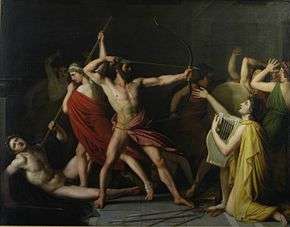
The next day, at Athena's prompting, Penelope maneuvers the Suitors into competing for her hand with an archery competition using Odysseus' bow. The man who can string the bow and shoot an arrow through a dozen axe heads would win. Odysseus takes part in the competition himself: he alone is strong enough to string the bow and shoot the arrow through the dozen axe heads, making him the winner. He then throws off his rags and kills Antinous with his next arrow. Then, with the help of Athena, Odysseus, Telemachus, Eumaeus, and Philoetius the cowherd he kills the other Suitors, first using the rest of the arrows and then by swords and spears once both sides armed themselves. Once the battle is won, Telemachus also hangs twelve of their household maids whom Eurycleia identifies as guilty of betraying Penelope or having sex with the Suitors. They mutilate and kill the goatherd Melanthius, who had mocked and abused Odysseus and brought weapons and armor to the suitors. Now, at last, Odysseus identifies himself to Penelope. She is hesitant but recognizes him when he mentions that he made their bed from an olive tree still rooted to the ground. Many modern and ancient scholars take this to be the original ending of the Odyssey, and the rest to be an interpolation.
The next day he and Telemachus visit the country farm of his old father Laertes, who likewise accepts his identity only when Odysseus correctly describes the orchard that Laertes had previously given him.
The citizens of Ithaca have followed Odysseus on the road, planning to avenge the killing of the Suitors, their sons. Eupheithes, their leader and father of Antinous, points out that Odysseus has now caused the deaths of two generations of the men of Ithaca: his sailors, not one of whom survived; and the Suitors, whom he has now executed. Athena intervenes in a dea ex machina and persuades both sides to give up the vendetta. After this, Ithaca is at peace once more, concluding the Odyssey.
Character of Odysseus
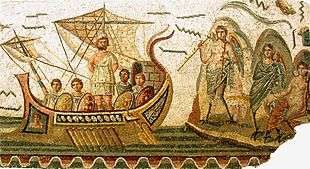
The name Odysseus (Ὀδυσσεύς) means "trouble" in Greek, referring to both the giving and receiving of trouble—as is often the case in his wanderings. An early example of this is the boar hunt that gave Odysseus the scar by which Eurycleia recognizes him; Odysseus is injured by the boar and responds by killing it.
Odysseus' heroic trait is his mētis, or 'cunning intelligence.' He is often described as the "Peer of Zeus in Counsel." This intelligence is most often manifested by his use of disguise and deceptive speech. His disguises take forms both physical (altering his appearance) and verbal, such as telling the Cyclops Polyphemus that his name is Οὖτις, ''Nobody'', then escaping after blinding Polyphemus. When asked by other Cyclopes' why he is screaming, Polyphemus replies that "Nobody" is hurting him, so the others assume that "if alone as you are [Polyphemus] none uses violence on you, why, there is no avoiding the sickness sent by great Zeus; so you had better pray to your father, the lord Poseidon."[7]
One flaw that Odysseus displays is that of arrogance and pride (or hubris). As he sails away from the island of the Cyclopes, he shouts his name and boasts that nobody can defeat the "Great Odysseus." The Cyclops then throws the top half of a mountain at him and prays to his father, Poseidon, saying that Odysseus has blinded him. This enrages Poseidon, causing the god to thwart Odysseus' homecoming for a decade.
Structure
The Odyssey is written in dactylic hexameter. It opens in medias res, in the middle of the overall story, with prior events described through flashbacks or storytelling.
The first four books of the poem trace Telemachus' efforts to assert control of the household, and then, at Athena's advice, his efforts to search for news of his long-lost father. Then the scene shifts: Odysseus has been a captive of the beautiful nymph Calypso, with whom he has spent seven of his ten lost years. Released by the intercession of his patroness Athena, through the aid of Hermes, he departs, but his raft is destroyed by his divine enemy Poseidon, who is angry because Odysseus blinded his son, Polyphemus. When Odysseus washes up on Scherie, home to the Phaeacians, he is assisted by the young Nausicaä and is treated hospitably. In return, he satisfies the Phaeacians' curiosity, telling them, and the reader, of all his adventures since departing from Troy. The shipbuilding Phaeacians then loan him a ship to return to Ithaca, where he is aided by the swineherd Eumaeus, meets Telemachus, regains his household by killing the Suitors, and is reunited with his faithful wife, Penelope.
Books
All ancient and nearly all modern editions and translations of the Odyssey are divided into 24 books. This division is convenient, but may not be original, as many scholars believe it was developed by Alexandrian editors of the 3rd century BC. Moreover, in the Classical period, several of the books (individually and in groups) were commonly given their own titles:
- Book 1–4: Telemachy (Telemachus + mákhē, 'battle')—the story focuses on the perspective of Telemachus.
- Books 9–12: Apologoi ('story within a story';[8] from apologus, 'narrative')—Odysseus recalls his adventures for his Phaeacian hosts.
- Book 9: Cyclopeia—Odysseus' encounter with the Polyphemus.
- Book 11: Nekuia—Odysseus meets with the spirits of the dead.
- Book 22: Mnesterophonia ('slaughter of the suitors'; Mnesteres, 'suitors' + phónos, 'slaughter').
Book 22 concludes the Greek Epic Cycle, though fragments remain of the "alternative ending" of sorts known as the Telegony. The Telegony aside, the last 548 lines of the Odyssey, corresponding to Book 24, are believed by many scholars to have been added by a slightly later poet.[9] Several passages in earlier books seem to be setting up the events of Book 24, so if it were indeed a later addition, the offending editor would seem to have changed earlier text as well. For more about varying views on the origin, authorship and unity of the poem see Homeric scholarship.
Geography of the Odyssey
The events in the main sequence of the Odyssey (excluding Odysseus' embedded narrative of his wanderings) take place in the Peloponnese and in what are now called the Ionian Islands.[10] There are difficulties in the apparently simple identification of Ithaca, the homeland of Odysseus, which may or may not be the same island that is now called Ithakē (Ιθάκη). The wanderings of Odysseus as told to the Phaeacians, and the location of the Phaeacians' own island of Scheria, pose more fundamental problems, if geography is to be applied: scholars, both ancient and modern, are divided as to whether or not any of the places visited by Odysseus (after Ismaros and before his return to Ithaca) are real.[11]
Influences on the Odyssey

Scholars have seen strong influences from Near Eastern mythology and literature in the Odyssey. Martin West has noted substantial parallels between the Epic of Gilgamesh and the Odyssey.[12] Both Odysseus and Gilgamesh are known for traveling to the ends of the earth, and on their journeys go to the land of the dead. On his voyage to the underworld, Odysseus follows instructions given to him by Circe. Her island, Aeaea, is located at the edges of the world and seems to have close associations with the sun. Like Odysseus, Gilgamesh gets directions on how to reach the land of the dead from a divine helper: in this case, the goddess Siduri, who, like Circe, dwells by the sea at the ends of the earth. Her home is also associated with the sun: Gilgamesh reaches Siduri's house by passing through a tunnel underneath Mt. Mashu, the high mountain from which the sun comes into the sky. West argues that the similarity of Odysseus' and Gilgamesh's journeys to the edges of the earth are the result of the influence of the Gilgamesh epic upon the Odyssey.
In 1914, paleontologist Othenio Abel surmised the origins of the Cyclops to be the result of ancient Greeks finding an elephant skull.[13] The enormous nasal passage in the middle of the forehead could have looked like the eye socket of a giant, to those who had never seen a living elephant.[13] Classical scholars, on the other hand, have long realized that the story of the Cyclops was originally a folk tale, which existed independently of the Odyssey and which only became embedded in it at a later date. Similar stories are found in cultures across Europe and the Middle East.[14]:127–31 According to this explanation, the Cyclops was originally simply a giant or ogre, much like Humbaba in the Epic of Gilgamesh.[14]:127–31 The detail about it having one eye was simply invented in order to explain how the creature was so easily blinded.[14]:124–5
Themes and patterns
Type scenes
Finding scenes occur in the Odyssey when a character discovers another character within the epic. Finding scenes proceed as followed:[15]
- The character encounters or finds another character.
- The encountered character is identified and described.
- The character approaches and then converses with the found character.
These finding scenes can be identified several times throughout the epic including when Telemachus and Pisistratus find Menelaus when Calypso finds Odysseus on the beach, and when the suitor Amphimedon finds Agamemnon in Hades.[15][16]
Homecoming
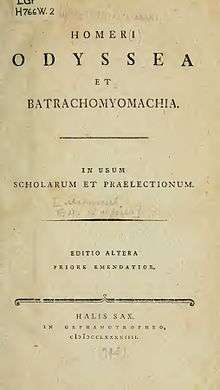
An important factor to consider about Odysseus' homecoming is the hint at potential endings to the epic by using other characters as parallels for his journey.[17] For instance, one example is that of Agamemnon's homecoming versus Odysseus' homecoming. Upon Agamemnon's return, his wife Clytemnestra and her lover, Aegisthus kill Agamemnon. Agamemnon's son, Orestes, out of vengeance for his father's death, kills Aegisthus. This parallel compares the death of the suitors to the death of Aegisthus and sets Orestes up as an example for Telemachus.[17] Also, because Odysseus knows about Clytemnestra's betrayal, Odysseus returns home in disguise in order to test the loyalty of his own wife, Penelope.[17] Later, Agamemnon praises Penelope for not killing Odysseus. It is because of Penelope that Odysseus has fame and a successful homecoming. This successful homecoming is unlike Achilles, who has fame but is dead, and Agamemnon, who had an unsuccessful homecoming resulting in his death.[17]
Wandering
Only two of Odysseus's adventures are described by the poet. The rest of Odysseus' adventures are recounted by Odysseus himself. The two scenes that the poet describes are Odysseus on Calypso's island and Odysseus' encounter with the Phaeacians. These scenes are told by the poet to represent an important transition in Odysseus' journey: being concealed to returning home.[15]
Calypso's name comes from the Greek word kalúptō (καλύπτω), meaning 'to cover' or 'conceal', which is apt, as this is exactly what she does with Odysseus.[18] Calypso keeps Odysseus concealed from the world and unable to return home. After leaving Calypso's island, the poet describes Odysseus' encounters with the Phaeacians—those who "convoy without hurt to all men"[19]—which represents his transition from not returning home to returning home.[15] Also, during Odysseus' journey, he encounters many beings that are close to the gods. These encounters are useful in understanding that Odysseus is in a world beyond man and that influences the fact he cannot return home.[15] These beings that are close to the gods include the Phaeacians who lived near the Cyclopes,[20] whose king, Alcinous, is the great-grandson of the king of the giants, Eurymedon, and the grandson of Poseidon.[15] Some of the other characters that Odysseus encounters are Polyphemus who is the Cyclops son of Poseidon, God of Oceans, Circe who is the sorceress daughter of the Sun that turns men into animals, Calypso who is a goddess, and the Laestrygonians who are cannibalistic giants.[15]
Guest-friendship
Throughout the course of the epic, Odysseus encounters several examples of xenia ("guest-friendship"), which provide models of how hosts should and should not act.[21][22] The Phaeacians demonstrate exemplary guest-friendship by feeding Odysseus, giving him a place to sleep, and granting him many gifts and a safe voyage home, which are all things a good host should do. Polyphemus demonstrates poor guest-friendship. His only "gift" to Odysseus is that he will eat him last.[22] Calypso also exemplifies poor guest-friendship because she does not allow Odysseus to leave her island.[22] Another important factor to guest-friendship is that kingship implies generosity. It is assumed that a king has the means to be a generous host and is more generous with his own property.[22] This is best seen when Odysseus, disguised as a beggar, begs Antinous, one of the suitors, for food and Antinous denies his request. Odysseus essentially says that while Antinous may look like a king, he is far from a king since he is not generous.[23]
Guest-friendship also follows a very specific pattern:
- The arrival and the reception of the guest.
- Bathing or providing fresh clothes to the guest.
- Providing food and drink to the guest.
- Questions may be asked of the guest and entertainment should be provided by the host.
- The guest should be given a place to sleep, and both the guest and host retire for the night.
- The guest and host exchange gifts, the guest is granted a safe journey home, and the guest departs.
Another important factor of guest-friendship is not keeping the guest longer than they wish and also promising their safety while they are a guest within the host's home.[21][22][16]
Testing
.jpg)
Another theme throughout the Odyssey is testing.[24] This occurs in two distinct ways. Odysseus tests the loyalty of others and others test Odysseus' identity. An example of Odysseus testing the loyalties of others is when he returns home.[24] Instead of immediately revealing his identity, he arrives disguised as a beggar and then proceeds to determine who in his house has remained loyal to him and who has helped the suitors. After Odysseus reveals his true identity, the characters test Odysseus' identity to see if he really is who he says he is.[24] For instance, Penelope tests Odysseus' identity by saying that she will move the bed into the other room for him. This is a difficult task since it is made out of a living tree that would require being cut down, a fact that only the real Odysseus would know, thus proving his identity. For more information on the progression of testing type scenes, read more below.[24]
Testing also has a very specific type scene that accompanies it as well. Throughout the epic, the testing of others follows a typical pattern. This pattern is:[24][16]
- Odysseus is hesitant to question the loyalties of others.
- Odysseus tests the loyalties of others by questioning them.
- The characters reply to Odysseus' questions.
- Odysseus proceeds to reveal his identity.
- The characters test Odysseus' identity.
- There is a rise of emotions associated with Odysseus' recognition, usually lament or joy.
- Finally, the reconciled characters work together.
Omens
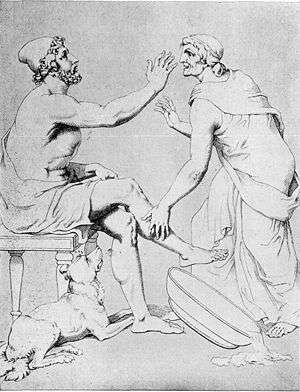
Omens occur frequently throughout the Odyssey, as well as in many other epics. Within the Odyssey, omens frequently involve birds.[25] It is important to note who receives the omens and what these omens mean to the characters and to the epic as a whole. For instance, bird omens are shown to Telemachus, Penelope, Odysseus, and the suitors.[25] Telemachus and Penelope receive their omens as well in the form of words, sneezes, and dreams.[25] However, Odysseus is the only character who receives thunder or lightning as an omen.[26][27] This is important to note because the thunder came from Zeus, the king of the gods. This direct relationship between Zeus and Odysseus represents the kingship of Odysseus.[25]
Omens are another example of a type scene in the Odyssey. Two important parts of an omen type scene are the recognition of the omen, followed by its interpretation.[25] In the Odyssey, all of the bird omens—with the exception of the first one in the epic—show large birds attacking smaller birds.[25][16] Accompanying each omen is a wish which can be either explicitly stated or only implied.[25] For example, Telemachus wishes for vengeance[28] and for Odysseus to be home,[29] Penelope wishes for Odysseus' return,[30] and the suitors wish for the death of Telemachus.[31] The omens seen in the Odyssey are also a recurring theme throughout the epic.[25][16]
Textual history
Since the late 19th century many papyri containing parts or even entire chapters have been found in Egypt, with content different from later medieval versions.[32] In 2018, the Greek Cultural Ministry revealed the discovery of a clay tablet near the Temple of Zeus, containing 13 verses from the Odyssey's 14th Rhapsody to Eumaeus. While it was initially reported to date from the 3rd century AD, the date still needs to be confirmed.[33][34]
In pop culture
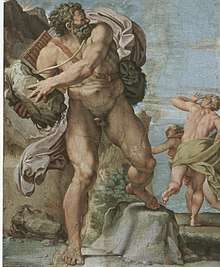
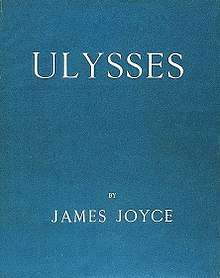
The Odyssey is regarded as one of the most important foundational works of western literature.[35] It is widely regarded by western literary critics as a timeless classic.[36] Straightforward retellings of the Odyssey have flourished ever since the Middle Ages. Other authors have composed more creative reworkings of the poem, often updated to address contemporary themes and concerns. In 2018, BBC Culture polled experts around the world to nominate the stories they felt had shaped mindsets or influenced history. Odyssey topped the list.[37][38]
Literature
- Merugud Uilix maicc Leirtis ('On the Wandering of Ulysses, son of Laertes') is an eccentric Old Irish version of the material, which exists in a 12th-century AD manuscript that linguists believe is based on an 8th-century original.[39]
- The first canto of Ezra Pound's The Cantos (1917) is both a translation and a retelling of Odysseus' journey to the underworld.[40]
- The poem "Ulysses" by Alfred, Lord Tennyson is narrated by an aged Ulysses who is determined to continue to live life to the fullest.
- James Joyce's modernist novel Ulysses (1922) is a retelling of the Odyssey set in modern-day Dublin. Each chapter in the book has an assigned theme, technique, and correspondences between its characters and those of Homer's Odyssey.[41]
- Homer's Daughter (1955) by Robert Graves is a novel imagining how the version we have might have been invented out of older tales.
- Omeros (1991), an epic poem by Derek Walcott, is in part a retelling of the Odyssey, set on the Caribbean island of St. Lucia.
- Daniel Wallace's Big Fish: A Novel of Mythic Proportions (1998) adapts the epic to the American South, while also incorporating tall tales into its first-person narrative much as Odysseus does in the Apologoi (Books 9-12).
- Margaret Atwood's 2005 novella The Penelopiad is an ironic rewriting of the Odyssey from Penelope's perspective.
- Zachary Mason's The Lost Books of the Odyssey (2007) is a series of short stories that rework Homer's original plot in a contemporary style reminiscent of Italo Calvino.
- The Heroes of Olympus (2010–2014) by Rick Riordan is based entirely on Greek mythology and includes many aspects and characters from the Odyssey.[42]
- Cyclops by Euripides, the only fully extant satyr play,[43] retells the episode involving Polyphemus with a humorous twist.[44]
- A True Story, written by Lucian of Samosata in the 2nd century AD, is a satire on the Odyssey and on ancient travel tales, describing a journey sailing westward, beyond the Pillars of Hercules and to the Moon, the first known text that could be called science fiction.[lower-roman 3]
Authors have sought to imagine new endings for the Odyssey. In canto XXVI of the Inferno, Dante Alighieri meets Odysseus in the eighth circle of hell, where Odysseus himself appends a new ending to the Odyssey in which he never returns to Ithaca and instead continues his restless adventuring.[45][46] Alfred, Lord Tennyson in turn expands on this variation in his poem, "Ulysses," published in 1842. Nikos Kazantzakis aspires to continue the poem and explore more modern concerns in his epic poem The Odyssey: A Modern Sequel, which was first published in 1938 in modern Greek.[47]
Film and television adaptations
- L'Odissea is a 1911 Italian silent film.
- Ulysses is a 1954 film adaptation which stars Kirk Douglas as Ulysses, with Silvana Mangano as Penelope and Circe, and Anthony Quinn playing Antinous.[48]
- L'Odissea is a 1968 Italian-French-German-Yugoslavian television miniseries praised for its faithful rendering of the original epic.[49]
- Ulysses 31 (1981) is a Japanese-French anime that updates the ancient setting into a 31st-century space opera.
- Ulysses' Gaze (1995), directed by Theo Angelopoulos, has many of the elements of the Odyssey set against the backdrop of the most recent and previous Balkan Wars.[41]
- The Odyssey is a 1997 television miniseries directed by Andrei Konchalovsky and starring Armand Assante as Odysseus and Greta Scacchi as Penelope.[50]
- O Brother, Where Art Thou? (2000), directed by the Coen Brothers, is very loosely based on Homer's poem.
Opera and music
- Il ritorno d'Ulisse in patria, first performed in 1640, is an opera by Claudio Monteverdi based on the second half of Homer's Odyssey.[51]
- Max Bruch’s choral work Odysseus told the main highlights of the hero’s story.
- Rolf Riehm composed an opera based on the myth, Sirenen – Bilder des Begehrens und des Vernichtens (Sirens – Images of Desire and Destruction) which premiered at the Oper Frankfurt in 2014.[52]
- Nick Cave & the Bad Seeds use the Odyssey to form the "narrative" of the song "More News from Nowhere," released in 2008 as a single and on the album Dig, Lazarus, Dig!!!. In the song, Cave uses a variety of contemporary names to represent the gods and nymphs who populate the Odyssey, and sketches key episodes from the epic across an eight-minute track.
- John Mackey's symphony for concert band, Wine-Dark Sea, tells three of the main highlights of the story in the piece's three movements.
- Robert W. Smith's second symphony for concert band, The Odyssey, tells four of the main highlights of the story in the piece's four movements: The Iliad, The Winds of Poseidon, The Isle of Calypso, and Ithaca.
- Sarah Kirkland Snider's song cycle, Penelope, is based on the faithful wife from Homer's Odyssey.
English translations
See also
References
Notes
- Odyssey 17.327 (Argos, the dog, dies): "autik' idont' Odusea eeikosto eniauto" ["seeing Odysseus again in the twentieth year"] cf. 2.174-6, 23.102, 23.170
- This theme once existed in the form of another epic, Nostoi, of which only fragments remain.
- "Lucian of Samosata, the Greco-Syrian satirist of the second century, appears today as an exemplar of the science-fiction artist. There is little, if any, need to argue that his mythopoeic Milesian Tales and his literary fantastic voyages and utopistic hyperbole comport with the genre of science fiction.…" (Swanson, Roy Arthur)
Citations
- "Odyssey". Random House Webster's Unabridged Dictionary.
- Rieu, D. C. H. 2003. Introduction to 'The Odyssey'. London: Penguin Books. p. xi.
- Reece (2011) marshals the evidence for an oral version of the epic that was at some point dictated to a scribe, and he reconstructs this oral-dictated version of the Odyssey. Reece, Steve. 2011. "Toward an Ethnopoetically Grounded Edition of Homer’s Odyssey." Oral Tradition 26:299–326.
- Knox, Bernard. 1996. "Introduction." Pp. 3–77 in The Odyssey, by Homer, translated by R. Fagles. New York: Penguin Books. ISBN 978-0-14-026886-7. p. 13.
- Fox, Robin Lane (2006). The Classical World: An Epic History from Homer to Hadrian. New York: Basic Books. p. 19. ISBN 978-0-465-02496-4.
- Homer. The Odyssey. p. Scroll 17 Line 8–8. Retrieved 16 January 2015.
- Homer, Odyssey 9 410–12, translated by Richmond Lattimore (pp. 147–48).
- "Apologoi." Simple English Wikipedia (2018).
- Carne-Ross, D. S. (1998). "The Poem of Odysseus." In The Odyssey, translated by R. Fitzgerald. New York: Farrar, Straus and Giroux. ISBN 978-0-374-52574-3. p. ixi.
- Strabo, Geographica, 1.2.15, as cited in Finley, Moses. 1976. The World of Odysseus (revised ed.). p. 33.
- Lane (2008) summarizes the literature in notes and bibliography. Fox, Robin Lane. 2008. "Finding Neverland." In Travelling Heroes in the Epic Age of Homer.
- West, Martin (1997). The East Face of Helicon: West Asiatic Elements in Greek Poetry and Myth. Oxford. 402–17.
- Mayor, Adrienne (2000). The First Fossil Hunters: Paleontology in Greek and Roman Times. Princeton University Press.
- Anderson, Graham (2000). Fairytale in the Ancient World. Routledge. pp. 127–31. ISBN 978-0-415-23702-4. Retrieved 22 June 2017.
- Thornton, Agathe (1970). "The Wanderings of Odysseus." Pp. 16–37 in People and Themes in Homer's Odyssey. Dunedin: University of Otago with London: Methuen.
- Edwards, Mark W. 1992. "Homer and the Oral Tradition." Oral Tradition 7(2):284–330.
- Thornton, Agathe (1970). "The Homecomings of the Achaeans." Pp. 1–15 in People and Themes in Homer's Odyssey. Dunedin: University of Otago with London: Methuen.
- "Calypso and Odysseus." Greek Myths & Greek Mythology (2010). Retrieved 5 May 2020.
- Homer, Odyssey, 8.566. (Lattimore 1975)
- Homer, Odyssey 6.4-5. (Lattimore 1975)
- Reece, Steve. 1993. The Stranger's Welcome: Oral Theory and the Aesthetics of the Homeric Hospitality Scene. Ann Arbor: University of Michigan Press.
- Thornton, Agathe (1970). "Guest-Friendship." Pp. 38–46 in People and Themes in Homer's Odyssey. Dunedin: University of Otago with London: Methuen.
- Homer, Odyssey, 17.415-44. (Lattimore 1975)
- Thornton, Agathe (1970). "Testing." Pp. 47–51 in People and Themes in Homer's Odyssey. Dunedin: University of Otago with London: Methuen.
- Thornton, Agathe (1970). "Omens." Pp. 52–57 in People and Themes in Homer's Odyssey. Dunedin: University of Otago with London: Methuen.
- Homer, Odyssey 20.103-4. (Lattimore 1975)
- Homer, Odyssey 21.414. (Lattimore 1975)
- Homer, Odyssey 2.143–5. (Lattimore 1975)
- Homer, Odyssey 15.155–9. (Lattimore 1975)
- Homer, Odyssey 19.136. (Lattimore 1975)
- Homer, Odyssey 20.240–43. (Lattimore 1975)
- "Oldest Greek Fragment of Homer Discovered on Clay Tablet". Smithonian. 2018.
- Tagaris, Karolina (July 10, 2018). Heavens, Andrew (ed.). "'Oldest known extract' of Homer's Odyssey discovered in Greece". Reuters.
- "Homer Odyssey: Oldest extract discovered on clay tablet". BBC. July 10, 2018.
- Bahr, Arthur. "Foundation of Western Literature". MIT Open Courseware. Massachusetts Institute of Technology. Retrieved 27 June 2017.
- Cartwright, Mark. "Odyssey". Ancient History Encyclopedia. Ancient History Encyclopedia. Retrieved 27 June 2017.
- 2018, 22 May. "The 100 stories that shaped the world". bbc.com.CS1 maint: numeric names: authors list (link)
- Haynes, Natalie. "The greatest tale ever told?". bbc.com.
- Meyer, Kuno, trans. 1886. Merugud Uilix maicc Leirtis: the Irish Odyssey (1st ed.). Strand, London: David Nutt. pp. v, 36. v–xii "Introduction;" 1–15 "Critical edition of Text;" 16–29 "Translation;" 30–36 "Index Verborum."
- Hesse, Eva (1969). New Approaches to Ezra Pound. University of California Press. p. 126.
- Grafton, Anthony; Most, Glenn W.; Settis, Salvatore (2010). The Classical Tradition. Cambridge, Massachusetts and London, England: The Belknap Press of Harvard University Press. p. 653. ISBN 978-0-674-03572-0.
- "When was Homer's Odyssey written? – Homework Help – eNotes.com". eNotes. Retrieved 2015-10-01.
- McHugh, Heather, trans. 2001. Cyclops; Greek Tragedy in New Translations, by Euripides. Oxford University Press. ISBN 9780198032656.
- Dougherty, Carol. 1999. “The Double Vision of Euripides' Cyclops: An Ethnographic Odyssey on the Satyr Stage.” Comparative Drama 33(3):313–38.
- Inferno, Canto XXVI, lines 98-99.
- Grafton, Anthony; Most, Glenn W.; Settis, Salvatore (2010). The Classical Tradition. Cambridge, MA: The Belknap Press. p. 652. ISBN 978-0-674-03572-0.
- Grafton, Anthony; Most, Glenn W.; Settis, Salvatore (2010). The Classical Tradition. Cambridge, Massachusetts and London, England: The Belknap Press of Harvard University Press. pp. 652–653. ISBN 978-0-674-03572-0.
- Wilson, Wendy S.; Herman, Gerald H. (2003). World History On The Screen: Film And Video Resources:grade 10-12. Walch Publishing. p. 3. ISBN 9780825146152.
- Garcia Morcillo, Marta; Hanesworth, Pauline; Lapeña Marchena, Óscar (11 February 2015). Imagining Ancient Cities in Film: From Babylon to Cinecittà. Routledge. p. 139. ISBN 9781135013172.
- Roman, James W. (2005). From Daytime to Primetime: The History of American Television Programs. Greenwood Publishing Group. p. 267. ISBN 9780313319723.
- "Monteverdi's 'The Return of Ulysses'". NPR.org. Retrieved 2017-02-24.
- Griffel, Margaret Ross (2018). "Sirenen". Operas in German: A Dictionary. Rowman & Littlefield. p. 448. ISBN 9781442247970.
Bibliography
- Lattimore, Richmond, trans. 1975. The Odyssey of Homer. New York: Harper & Row.
| Library resources about Odyssey |
Further reading
- Austin, N. 1975. Archery at the Dark of the Moon: Poetic Problems in Homer’s Odyssey. Berkeley: University of California Press.
- Clayton, B. 2004. A Penelopean Poetics: Reweaving the Feminine in Homer's Odyssey. Lanham: Lexington Books.
- — 2011. "Polyphemus and Odysseus in the Nursery: Mother’s Milk in the Cyclopeia." Arethusa 44(3):255–77.
- Bakker, E. J. 2013. The Meaning of Meat and the Structure of the Odyssey. Cambridge: Cambridge University Press.
- Barnouw, J. 2004. Odysseus, Hero of Practical Intelligence. Deliberation and Signs in Homer's Odyssey. Lanham, MD: University Press of America.
- Dougherty, C. 2001. The Raft of Odysseus: The Ethnographic Imagination of Homer's Odyssey. New York: Oxford University Press.
- Fenik, B. 1974. Studies in the Odyssey. Hermes: Einzelschriften 30. Wiesbaden, West Germany: F. Steiner.
- Griffin, J. 1987. Homer: The Odyssey. Landmarks in World Literature. Cambridge: Cambridge University Press.
- Louden, B. 2011. Homer’s Odyssey and the Near East. Cambridge: Cambridge University Press.
- — 1999. The Odyssey: Structure, Narration and Meaning. Baltimore: Johns Hopkins University Press.
- Minchin, E. 2010. "The Expression of Sarcasm in the 'Odyssey'." Mnemosyne 63(4):533–56.
- Müller, W. G. 2015. "From Homer’s Odyssey to Joyce’s Ulysses: Theory and Practice of an Ethical Narratology." Arcadia 50(1):9–36.
- Perpinyà, Núria. 2008. Las criptas de la crítica. Veinte lecturas de la Odisea [The Crypts of Criticism: Twenty Interpretations of the 'Odyssey']. Madrid: Gredos. Lay summary via El Cultural (in Spanish).
- Reece, Steve. 1993. The Stranger's Welcome: Oral Theory and the Aesthetics of the Homeric Hospitality Scene. Ann Arbor: University of Michigan Press.
- — 2011. "Toward an Ethnopoetically Grounded Edition of Homer’s Odyssey." Oral Tradition 26:299–326.
- — 2011. "Penelope's Early Recognition’ of Odysseus from a Neoanalytic and Oral Perspective." College Literature 38(2):101–17.
- Saïd, S. 2011 [1998].. Homer and the Odyssey. New York: Oxford University Press.
- Turkeltaub, D. 2014. “Penelope's ‘Stout Hand’ and Odyssean Humour.” The Journal of Hellenic Studies 134:103–19.
- West, E. 2014. “Circe, Calypso, Hiḍimbā.” Journal of Indo-European Studies 42(1):144–74.
External links
| Look up odyssey in Wiktionary, the free dictionary. |
| Wikisource has original text related to this article: |
| Greek Wikisource has original text related to this article: |
| Wikimedia Commons has media related to Odyssey. |
| Wikiversity has learning resources about The Odyssey |
- The Odyssey (in Ancient Greek) on Perseus Project

- BBC audio file — In our time BBC Radio 4 [discussion programme, 45 mins]
- The Odyssey Comix — A detailed retelling and explanation of Homer's Odyssey in comic-strip format by Greek Myth Comix
- Images of scenes from Homer's the Odyssey
- The Odyssey — Annotated text and analyses aligned to Common Core Standards
- "Homer's Odyssey: A Commentary" by Denton Jaques Snider on Project Gutenberg
- The Meaning of Tradition in Homer's Odyssey
Translations
- The Odysseys of Homer, together with the shorter poems by Homer, trans. by George Chapman at Project Gutenberg
- The Odyssey, trans. by Alexander Pope at Project Gutenberg
- The Odyssey, trans. by William Cowper at Project Gutenberg
- The Odyssey, trans. by Samuel H. Butcher and Andrew Lang at Project Gutenberg
- The Odyssey, trans. by Samuel Butler at Project Gutenberg
- The Odyssey, trans. by A. T. Murray (1919) on Perseus Project
